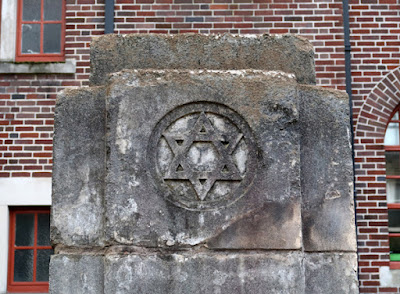 |
| The Jubilee Monument in Endcliffe Park |
Arriving at Sheffield Botanical Gardens, having had a quick exploration of the historic architecture in parts of the Broomhill and Endcliffe Conservation Areas, I still had several listed buildings and various other structures and monuments to photograph for the British Listed Buildings website, before finishing for the day.
 |
| The 'Paxton' Pavilions at Sheffield Botanical Gardens |
The first of these were the two Grade II* Listed south-west and north-east glasshouses (1838), which form part of the 'Paxton' Pavilions by Benjamin Broomhead Taylor, who also co-designed the Cutlers' Hall (1832) in Sheffield with Samuel Worth.
The pavilions were restored in 2003, with new planting beds built with Stoke Hall stone from the Kinderscout Grit in Grindleford and Rough Rock from the Crosland Hill quarry in Huddersfield used for the floors. The stone to the external pilasters had apparently been laid face bedded and repaired with Portland cement render, leading to its deterioration. Some of these have been refaced with new stone and new Corinthian capitals added, but I did not get near enough to closely study the stonework on this occasion.
Having photographed the pavilions, I then went to find the Evolution Garden, in which there is a fine example of an Upper Carboniferous fossil tree stump – the giant club moss Lepidodendron - which is approximately 310 million years old, with several large lumps of coal beside it.
Heading down to the south entrance, I stopped briefly to photograph the south lodge, which was presumably built at the same time as the pavilions and main gateway (1836-38). Looking at a distance, the rock-faced iron stained sandstone is quite unlike the very uniformly buff coloured stone, which is probably Stoke Hall stone, used for the ‘Paxton’ Pavilions.
Continuing down to the south entrance, I stopped briefly to photograph the Grade II Listed gateway and railings (c1900), which are built of buff medium grained gritstone that looks exactly like the stone used for the pavilions.
I then walked down to Ecclesall Road, where I took a brief diversion to photograph the reconstituted stone piers to the gates and boundary walls at the former synagogue (1930) on Wilson Road, before continuing to Endcliffe Park.
Stopping to photograph the brick built Arts and Crafts style pavilion and lodge (1891), I went to find the Grade II Listed Jubilee monument and railing (1897), which is a dolmen like construction made of large boulders of coarse grained Chatsworth Grit, with the top stone inscribed, dated and containing a coat of arms.
On the previous occasions that I have visited Endcliffe Park, I had always approached it from the opposite direction and never noticed that the Jubilee monument was there, but this park is full of interesting details - such as the granite memorial to the 100th centenary of the ending of World War I, which I also never noticed before.
When planning my walk from the centre of Broomhill to Endcliffe Park, it had partly been my intention to start preparing an illustrated talk for the Ranmoor Society in September 2022 – to describe the relationship between the historic architecture and the underlying geology in a part of Sheffield that I don't know particularly well.
It was also the occasion of my birthday and, having noted that the Tuk Tuk Thai Street Food restaurant had opened a few months earlier, I was very keen to try it out – especially since I had not visited Khao Gaeng Thai in Leeds for a long time, due to the COVID-19 Pandemic.
Returning home after a very good meal, I enjoyed a nice bottle of Campo Viejo Rioja Garnacha, while contemplating my next day out in Sheffield with the Sheffield U3A Geology Group - to explore the geology, natural history and industrial archaeology of the Shirtcliffe Valley.











No comments:
Post a Comment